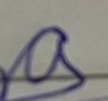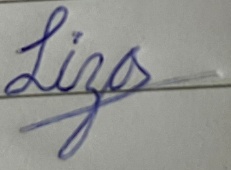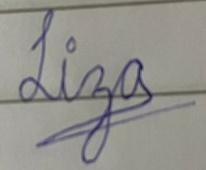REPORT ON SIGNATURE ANALYSIS (EXPERT OPINION ON THE
SAMPLES PROVIDED)
CASE -
EXPERT OPINION ON SIGNATURE SAMPLES PROVIDED
DATE
– 1/10/2023
FIR NUMBER – 676767
EXAMINEE NAME – AAYUSHI BHASIN
CONTACT INFORMATION – 989733XXXX
MODE OF RECEIPT OF MATERIAL – Hard copy (1st generation copy of
signature via post)
SAMPLING METHOD- Questioned sample(Q1) along with a requested natural
writing sample(S1)
CONDITION OF PARCEL – Sealed and well preserved, chain of custody
maintained.
DESCRIPTION OF PARCEL – Two papers were received, one for reference
signature (reference sample) and the other to be examined (questioned sample).
The paper was in a plastic sheet, sealed by the investigation officer (police
seal present of the respected station – Malviya Nagar, Delhi). The sheet was
secured in an envelope, marked with the case number, date, and signature of the
I.O.(Investigating officer) and suspects.
CASE SUMMARY
The case includes a disputed signature retrieved from
a cheque, which was claimed to be forged by Liza, the account holder whose
money was withdrawn via cheque through her account. The case was received on
the date 01/10/23. Two signatures were received, one as a reference for
sampling the original signature by Liza, marked as (S1) further, and the other
that was to be examined, the disputed one – marked as (Q1) as questioned
signature.
EXAMINATION AND INSTRUMENTS
TOOLS USED – magnifying lens, a scanner with high
magnification, digital camera.
Signature analysis is an essential forensic
investigative procedure to judge documents' authenticity and identify probable
forgery. The purpose of signature analysis is to determine whether the given
signature closely resembles the known signature of the alleged author or is
evidence of fraud.
The fundamental principle of signature analysis is
based on the belief that each person's handwriting is unique and exhibits
consistent patterns and idiosyncrasies. These distinctive characteristics,
often referred to as "individual characteristics" or
"individuality," are what forensic experts look for when examining
signatures. Signature analysis aims to identify the distinguishing features that
make one person's signature different from another's and to assess whether the
questioned signature aligns with the known exemplars provided.
Method of examination:
1)
The
first and foremost step is the collection of samples.
2)
Observe
both signatures under a magnifying lens and notice all the peculiarities, hand
movements, pen lifts, pauses, and all the other hesitation marks. Know that
there are always some natural variations, but we must focus on individual
variations. Collect more than one standard sample only after permission from
the court.
3)
Identify
and individualize the samples carefully by strokes, slants, movement of the
pen, etc.
ANALYSIS
S1
STANDARD SAMPLE
|
S.NO |
S1 |
Q1 |
OPINION |
|
1. |
|
|
|
|
|
The character is ‘L’ from Roman script. The
formation begins from the left-hand side forming an ascender which then
descends downward forming a staff which further forms an angular loop
terminating with a wavy stroke formation. The pen pressure is heavy. |
The character is ‘L’ from Roman script. The
formation begins with a hook at the top descending downwards with a staff.
There is an ovate loop formation at the bottom terminating with a diagonal stroke.
The pen pressure seems moderate. |
Dissimilar |
|
2 |
|
|
|
|
|
The character forms cursive small ‘i’ of Roman
script. The letter is in connection with the previous one forms a closed loop
and has a rightward slant. The dot lies a little above the stem. The
character lies above the baseline with heavy pen pressure. |
The character forms cursive small ‘i’ of Roman
script. The formation begins from the left downwards forming a vertical staff
which is then retraced downwards. The dot is a circular formation above the
stem. The character touches the baseline, and the pen pressure is moderate. |
Dissimilar |
|
3 |
|
|
|
|
|
The character forms a cursive letter ‘z’ of Roman script. It begins with a wedge touching the baseline which further
forms a downward angular narrow, slender long loop descending downward from
the baseline. It terminates with a sharp diagonal staff connecting to the
adjacent character. |
The character forms a cursive letter ‘ z’of Roman script.
It begins with a wedge which shows some hesitation marks. It is further connected
to a horizontal stroke which then descends downward to touch the baseline
which further forms a broad horizontal loop. |
Dissimilar |
|
4. |
|
|
|
|
|
The character is cursive ‘a’of Roman script. It
begins in connection with the previous character, forming a tented loop. A
spur is attached from the top of the loop diagonally rightward. It terminates
with an under stroke. |
The character is cursive ‘a’of Roman script. It
begins from leftward in connection to the previous character and forms an
ovate loop. It terminates with a diagonal hook in the leftward direction. |
Dissimilar |
|
5. |
|
|
|
|
|
The underlying stroke begins from the baseline and
runs forward with a diagonal stroke in a downward direction with heavy pen
pressure retraces backward in the left direction with light pen pressure and
terminates above the baseline. |
The underlying stroke begins below the baseline and
is projected diagonally rightwards which further forms an angle and retraces
the path with a distanced diagonal staff and terminates rightwards below the
baseline. |
Dissimilar |
Result
The signature specimen S1 and Q1 seems to be written
by different people as the above ‘5’ points of dissimilarities in letter
formation shows dissimilarities of most individual habit.
Opinion
On the cumulative effect of all the above reasons and
observations I am of the opinion, “The questioned signature marked as (Q1) seems
that has not been written by the same writer who has written the admitted
signature sample marked as (S1).”
Recommendation
Complete stability should be proven if more admitted
signatures are provided having legal acceptability.
Name : Aayushi Bhasin
Date – 05/10/2023















